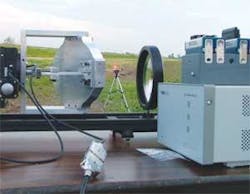If ever implemented, the proposed Space Elevator–a vehicle able to travel up and down a super-strong cable extending from Earth to geosynchronous orbit and beyond–would drastically cut the amount of energy and trouble needed to get payloads off Earth and to the Moon or other planets. While building the cable itself is the biggest hurdle to a practical system, a second problem is getting electric power to the elevator car so that it can pull itself up (an on-board source of electricity would be too heavy, and running electrical wiring up the cable would be too inefficient).
But developers of the idea are not deterred. In fact, they have created a competition in cooperation with NASA called the Space Elevator Games to help propel the concept into practicality. First held in 2005 at the NASA Ames Research Center (Mountain View, CA) for a $50,000 prize, the Games have grown this year to a $4 million competition held at Cape Canaveral (the prize money comes from NASA’s Centennial Challenges program). No one has ever won a prize; each year a team has come close, and each year the conditions for winning the prize have been made stricter. This year, high-power lasers made by Trumpf (Ditzingen, Germany) and Dilas (Mainz, Germany) are integral to the competition.
Games with a purpose
“The Space Elevator games were set up to address the two core technological barriers to building the Space Elevator–tether strength and power beaming,” says Ben Shelef of the Spaceward Foundation (Mountain View, CA), which founded the games. “We proposed the idea to NASA in 2004, with the idea that, while NASA does not have a space elevator on its roadmap, these technologies enable other exploration goals, which are, for example, construction of lighter rocket bodies and exploration of dark craters on the moon.”
The objective of the power-beaming games, Shelef explains, is to design, build, and operate vehicles that travel up a vertical tether, powered only through beamed power-transfer. The objective of the tether games is to create tethers with a higher specific strength than the best tether Spaceward can construct out of commercially available materials. “We started the games in 2005,” says Shelef. “In the power beaming, we used the simplest possible components–commercial xenon searchlights and practically ordinary rooftop photovoltaics.”
But by 2006, the projects advanced to the point where the potential of white light was exhausted. Dilas got interested at that point, after being contacted by team USST (University of Saskatchewan Space Science Team; Saskatoon, Saskatchewan, Canada). That year, the USST entry climbed the track at nearly the 1 m/s that was required to win the $200,000 prize.
“In 2007, the required speed was 2 m/s, and the serious contenders were USST, LaserMotive (both using Dilas equipment), and Kansas City Space Pirates, who used a solar concentrator,” says Shelef. “USST again finished first, but again was a few seconds too slow. As a result of the games and the grainy green-and-black video of the laser-powered climb, Trumpf got interested.” The required climbing speed for the 2009 games is 5 m/s, and the cable “race track” is 1 km tall (supported by a helicopter). The photovoltaic receivers are about 1 m across and the beams are automatically tracking.
Free light
In fact, Trumpf’s interest is strong enough that it has made available one of its 8 kW lasers, along with a technical crew, for use in this year’s games. Five contestant teams are taking advantage of the offer; one of them is the Kansas City Space Pirates, which is hoping to turn its own more than $200,000 investment into $2 million in prize money. (The prize is $900,000 for a successful 1 km climb at 2 m/s; another $1.1 million is thrown in if the speed of ascent is 5 m/s or faster. An additional $2 million is devoted to a separate cable-design competition.)
The disk laser is coupled into a 200-µm-diameter optical fiber, which results in a beam with a beam-parameter product of 8 mm-mrad. The KC Space Pirates built its own optical system (see figure) to direct the beam to its climber’s photovoltaic cells, which power the climber’s trip up the 3/16 in. cable.
“The KC Space Pirates entered the competition as a robotics competition that had prize money, unlike most robotics competitions,” says Brian Turner, the group’s leader. “Each year we thought it would be our last, but the prizes and our experience levels kept increasing so we kept coming back. We have had to use our robot-building skills and have added to that: solar-cell tech, optics, logistics, marketing, and now lasers. So much for it being a robotics competition.”
The diode alternative
Another team, LaserMotive (Seattle, WA), led by Jordin Kare, will be relying on high-brightness laser-diode sources that Dilas has offered to the contestants at a discount. LaserMotive is using dual-axis collimation with small-active-region bars to get higher initial radiance, polarization-combining to halve the effective width of the stacks, and an optical interleaver to combine two stacks, notes Kare.
“The diode wavelength is 810 nm, which we prefer to longer wavelengths (980 nm diodes or 1.03 to 1.06 µm diode-pumped solid-states lasers) because, courtesy of our Boeing partners, we have a set of very-high-efficiency gallium arsenide photovoltaic cells from Spectrolab (Sylmar, CA) for our power receiver that are well-matched to the 800 to 810 nm band,” he adds. “Dilas offered these sources with beam-expanding optics that would generate a 10-cm-square beam with controllable divergence, but we’ve chosen to use our own optics, since we had mirrors already ‘on the shelf’ from last year’s laser system. Overall, the radiance of the new sources is roughly twentyfold higher than last year’s.”
Weather permitting, the Space Elevator Games will be held April 29 at the Kennedy Space Center. The Spaceward Foundation (www.spaceward.org) will have live viewing of the event on its Web site, along with a concurrent blog.

